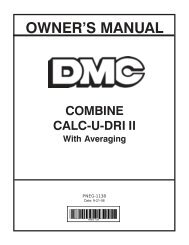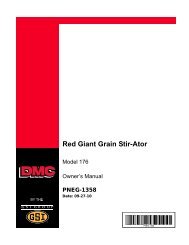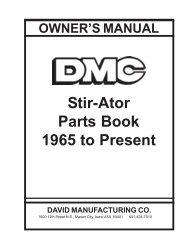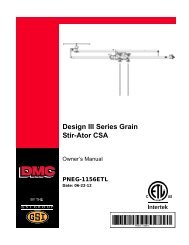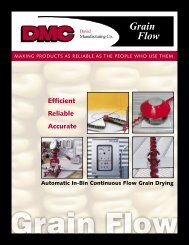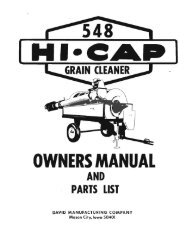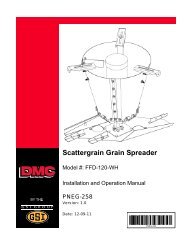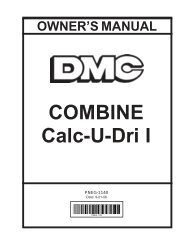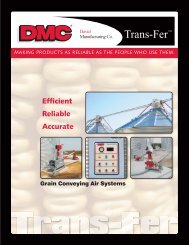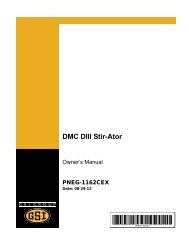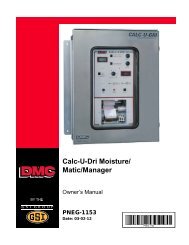Red Giant Grain Stir-Ator - David Manufacturing Co.
Red Giant Grain Stir-Ator - David Manufacturing Co.
Red Giant Grain Stir-Ator - David Manufacturing Co.
- No tags were found...
Create successful ePaper yourself
Turn your PDF publications into a flip-book with our unique Google optimized e-Paper software.
MAINTENANCE AND ADJUSTMENTS<br />
<strong>Red</strong> <strong>Giant</strong> <strong>Stir</strong>-<strong>Ator</strong><br />
The <strong>Red</strong> <strong>Giant</strong> <strong>Grain</strong> <strong>Stir</strong>-<strong>Ator</strong> has been designed so that a minimum of maintenance and adjustment will be<br />
needed; however, as with any piece of machinery, some adjustments and periodic maintenance could become<br />
a necessity.<br />
1. Check and fill to the proper level, all gear boxes, using 90-weight gear lube. This should be done every<br />
25,000 bushels dried or once a year, whichever occurs first.<br />
2.<br />
ALL GEARBOXES ARE SHIPPED FROM THE FACTORY WITHOUT LUBRICANT.<br />
3. Auger flighting should be inspected yearly. Excessive auger flighting wear will cause poor, uneven stirring.<br />
4. Augers should be replaced when cutting edge has been worn down so that instead of having a 1/4" flat<br />
cutting edge, it is now razor sharp. Always replace worn augers in sets. Plain augers come as standard<br />
equipment on your <strong>Red</strong> <strong>Giant</strong>. Should you be experiencing excessive auger wear, perhaps you sould be<br />
using a hard-surfaced auger. Hard-surface augers are substantially more expensive to purchase; however,<br />
you can expect approximately three times the life expentancy over plain augers. When installing new augers,<br />
be sure that they are cut off three inches above the bin floor.<br />
5. The cast auger couplers need to be tightened evenly to avoid excessive auger vibration. Should an auger<br />
coupler not draw up evenly, it can in most cases be remedied by simply taking the bolts loose, and turn onehalf<br />
of the coupler over, then rebolt and tighten all the bolts up in an even pattern. BE SURE THE AUGERS<br />
ARE NOTCHED and center coupler bolts are put through notches in gearbox stub shaft and also notches<br />
that have been filed in the auger shaft. See Drawing N on page 57.<br />
6. Belt Tension: The BX-48 matched V-belts driving from the heavy-duty motor to the top drive-shaft should<br />
be inspected after each bin of grain is dried. The belt tension is adjusted by loosening the heavy-duty motor,<br />
and turning the cam (See Drawing H on page 55) until the proper belt tension is achieved which is 3/8"<br />
deflection at 7 pounds of pressure. See Drawing J & page 55. The other matched V-belts have a springloaded<br />
clutch idler so proper tension is maintained at all times. Checking for proper belt alignment and<br />
proper clutch-idler operation is all that is necessary.<br />
7. Roller Chain: The roller chain center drive system moves the <strong>Red</strong> <strong>Giant</strong> trolley in and out, allowing it to<br />
stir the entire contents of the grain in your bin. This chain needs to be kept to the specifications shown in<br />
Drawing K on page 56. If this chain is operating when the tension is too tight, it will place undue wear on the<br />
idler pulleys. If it is too loose, it is possible for it to come off the drive sprocket.<br />
PNEG-1358 <strong>Red</strong> <strong>Giant</strong> <strong>Stir</strong>-<strong>Ator</strong><br />
69



